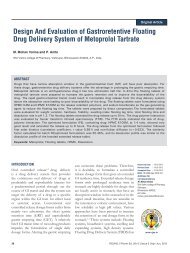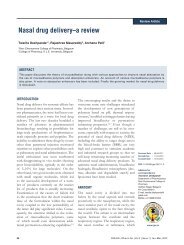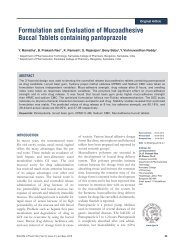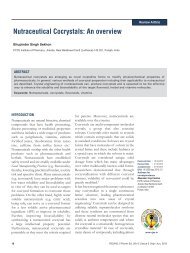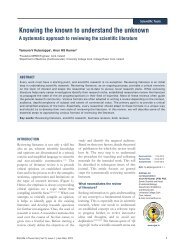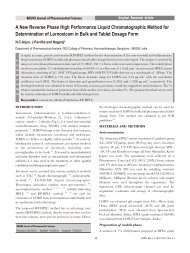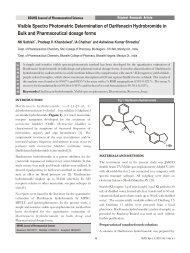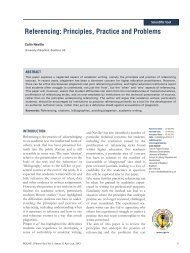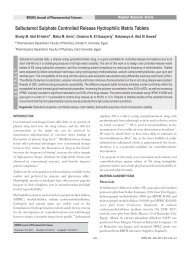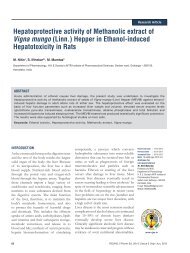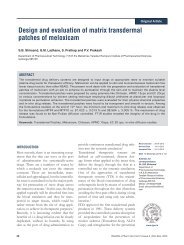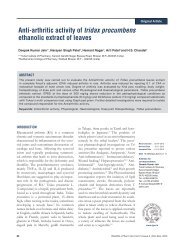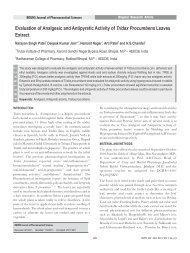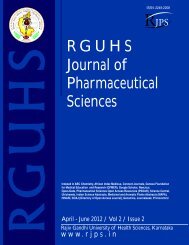Chitosan Loaded Mucoadhesive Microspheres of Gliclazide - Journal
Chitosan Loaded Mucoadhesive Microspheres of Gliclazide - Journal
Chitosan Loaded Mucoadhesive Microspheres of Gliclazide - Journal
Create successful ePaper yourself
Turn your PDF publications into a flip-book with our unique Google optimized e-Paper software.
OBJECTIVES<br />
1) To formulation <strong>of</strong> controlled mucoadhesive buccal drug<br />
delivery system by using central composite design.<br />
2) To improve the bioavailability by passing the first pass<br />
effect.<br />
3) To perform the evaluation studies for thickness,<br />
hardness, weight variation, friability and In vitro drug release.<br />
MATERIALS AND METHOD<br />
Materials<br />
Prakash Rao B et al./ Formulation and Evaluation <strong>of</strong> <strong>Mucoadhesive</strong> Buccal Drug Delivery System <strong>of</strong> Metoprolol Tartrate by Using Central Composite Design<br />
Metoprolol Tartrate was obtained as a gift sample from<br />
Novartis pharmaceutical LTD (Mumbai, India). Carbopol<br />
934P and magnesium stearate were purchased by S.D Fine<br />
Chem. LTD. (Mumbai, India). HPC was received as gift<br />
sample from Strides Arco labs LTD (Bangalore, India). All<br />
other chemicals and reagents were <strong>of</strong> analytical grade.<br />
14<br />
Experimental Design<br />
Central composite design (CCD) was selected for the<br />
development <strong>of</strong> the formulation. CCD has three groups <strong>of</strong><br />
design points, two-level factorial or fractional factorial design<br />
points, axial points (sometimes called "star" points) and<br />
central points. Central points are usually repeated 4-6 times to<br />
get a good estimate <strong>of</strong> experimental error. Central composite<br />
designs have 5 levels <strong>of</strong> each factor: -Alpha, -1, 0, 1, and<br />
+Alpha (Table 1). Effect <strong>of</strong> carbopol (A) and effect <strong>of</strong> HPC (B)<br />
was selected as independent variables. Higher (+1) and lower<br />
(-1) value <strong>of</strong> the independent variables were selected and<br />
calculate the alpha value. These values were put in the<br />
optimization s<strong>of</strong>tware and get the different formulation given<br />
in the (Table 2). The drug release after 8 hours (R 1),<br />
bioadhesive strength (R 2), T 50% (time for 50% <strong>of</strong> drug release)<br />
(R3) and diffusion coefficient (n) (R4) were selected as<br />
responses.<br />
Preparation <strong>of</strong> Buccal Tablet<br />
Buccal tablets <strong>of</strong> MT were prepared by direct compression<br />
method. All the ingredients without magnesium stearate were<br />
accurately weighed and mixed in mortar with a pestle for 10<br />
minutes to get the uniform powder. After sufficient mixing <strong>of</strong><br />
drug and polymer, magnesium stearate was added and mixed<br />
for 3 min. The blended powder was compressed into tablets by<br />
using the Rimek mini press –I compression machine. The<br />
quantities <strong>of</strong> various ingredients are shown in (Table 2).<br />
Evaluation <strong>of</strong> Buccal Tablets<br />
Thickness<br />
Thickness <strong>of</strong> the tablet was measured by using the digital<br />
vernier callipers (Aerospace, china).Thickness is expressed in<br />
15<br />
millimeters.<br />
Hardness<br />
The hardness <strong>of</strong> the tablet was measured using the Monsanto<br />
hardness tester (Scientific engineering corp., Delhi, India). It<br />
2 16<br />
is expressed in Kg/cm .<br />
Weight Variation Test<br />
20 Tablets were taken from each batch and individually<br />
weighed by Electronic balance. Average weight <strong>of</strong> the tablets<br />
was calculated and deviation from the actual weight was<br />
16<br />
determined.<br />
16<br />
Friability<br />
Friability generally refers to the loss in weight <strong>of</strong> tablets in the<br />
containers due to the removal <strong>of</strong> fines from the tablet surface.<br />
Friability generally reflects poor cohesion <strong>of</strong> tablet<br />
ingredients. 10 tablets were weighed, initial weight <strong>of</strong> these<br />
tablets were recorded and placed in Roche friabilator and<br />
rotated at the speed <strong>of</strong> 25 rpm for 100 revolutions. Then,<br />
tablets were removed from friabilator, dusted <strong>of</strong>f the fines and<br />
Table 2: List <strong>of</strong> working formulations<br />
Run Carbopol( X 1 ) HPC ( X 2 ) Design<br />
(mg) (mg) point<br />
F-1 65.00 65.00 Centre<br />
F-2 65.00 65.00 Center<br />
F-3 15.50 65.00 Axial<br />
F-4 65.00 65.00 Centre<br />
F-5 30.00 30.00 Fact<br />
F-6 30.00 100.00 Fact<br />
F-7 100.00 30.00 Fact<br />
F-8 100.00 100.00 Fact<br />
F-9 65.00 65.00 Centre<br />
F-10 114.50 65.00 Axial<br />
F-11 65.00 15.50 Axial<br />
F-12 65.00 114.50 Axial<br />
F-13 65.00 65.00 Centre<br />
Each formulation contain 50 mg <strong>of</strong> MT<br />
Table 1: Factors and their corresponding levels implemented for the construction <strong>of</strong> CCD<br />
Independent<br />
variable(Factor)<br />
-Alpha( α)<br />
-1 0 +1 +alpha(α)<br />
Carbopol 15.50 30 65 100 114.50<br />
HPC 15.50 30 65 100 114.50<br />
147<br />
RJPS, Jul - Sep, 2011/ Vol 1/ Issue 2



